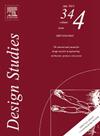AI-against-design map: A systematic review of 20 years of AI-focused studies in design research
IF 3.2
1区 工程技术
Q2 ENGINEERING, MANUFACTURING
引用次数: 0
Abstract
In the rapidly evolving field of Artificial Intelligence (AI) in design, identifying key subjects and their development over time can be challenging. This study addresses this challenge through a systematic review of AI in design literature over the past 20 years, aiming to discern major academic trajectories. To manage the fragmented nature of the literature, we developed the ‘AI-against-design’ method, an interpretative approach capable of identifying the scholars' position, intended as Position = Place ∪ Proposition, which creates a coherent body of literature and highlights key discourse patterns. This approach led to the development of the ‘AI-against-design’ map, which provides insights into current trends and serves as a tool for exploring future research directions. The scalability of this method and map allows for the future inclusion of additional sources and adaptation to other studies. This framework promises to enhance understanding and stimulate new academic inquiries into AI's role in design.
人工智能对抗设计地图:对20年来设计研究中以人工智能为重点的研究的系统回顾
在快速发展的人工智能(AI)设计领域,确定关键主题及其随时间的发展可能具有挑战性。本研究通过对过去20年设计文献中人工智能的系统回顾来解决这一挑战,旨在辨别主要的学术轨迹。为了管理文献的碎片性,我们开发了“人工智能反设计”方法,这是一种能够识别学者立场的解释性方法,即位置=地点∪命题,它创建了一个连贯的文献体,并突出了关键的话语模式。这种方法导致了“人工智能对抗设计”地图的发展,该地图提供了对当前趋势的见解,并作为探索未来研究方向的工具。这种方法和地图的可扩展性允许未来纳入其他来源和适应其他研究。这个框架有望增进对人工智能在设计中的作用的理解,并激发新的学术研究。
本文章由计算机程序翻译,如有差异,请以英文原文为准。
求助全文
约1分钟内获得全文
求助全文
来源期刊

Design Studies
工程技术-工程:制造
CiteScore
8.60
自引率
20.00%
发文量
41
审稿时长
40 days
期刊介绍:
Design Studies is a leading international academic journal focused on developing understanding of design processes. It studies design activity across all domains of application, including engineering and product design, architectural and urban design, computer artefacts and systems design. It therefore provides an interdisciplinary forum for the analysis, development and discussion of fundamental aspects of design activity, from cognition and methodology to values and philosophy.
Design Studies publishes work that is concerned with the process of designing, and is relevant to a broad audience of researchers, teachers and practitioners. We welcome original, scientific and scholarly research papers reporting studies concerned with the process of designing in all its many fields, or furthering the development and application of new knowledge relating to design process. Papers should be written to be intelligible and pertinent to a wide range of readership across different design domains. To be relevant for this journal, a paper has to offer something that gives new insight into or knowledge about the design process, or assists new development of the processes of designing.
 求助内容:
求助内容: 应助结果提醒方式:
应助结果提醒方式:


